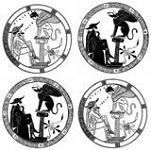Our websites offer information mostly for educational purposes with no intent to alter health care protocols nor to serve as a sole source of medical information.
Always seek the advice of your local health care provider.
|
×  Get the Point! PAIN – WOMAN – UKRAINE – PUTIN MOTHER – SISTER – SPOUSE – MOTHER RUSSIAN WAR – HOLOCAUST – GENOCIDE |
PALE ANEMIA LIVID ANEMONE MALADY MALARIA
MALADY MAL-AREA MALARIA
Pale Pallor Paleness
PALe or in Latin PALlidus implies "not bright" and is a SIGN that may or may not be a SIGNAL of ANEMIA which implies "lack of BLOOD" ("the root "EMIA" as in septicEMIA stands for "what pertains to blood"). In contrast, ANEMONE is a blood-like bright red wild flower growing in WINDy areas (note "wind" pointing to "breathing"). These are "think words" and roots to better understand and remember the implications inherent to ANEMIA and associated signs such as PALLOR, PALLUDISM, PALO (appaling), MALARIA, DYSPNEA or SHORTNESS OF WIND or BREATH, and being LIVID. Anemone also reminds us of VENUS (her beauty made some males "livid and breathless" - she chose this red flower as a symbol of her love for Adonis whose death was bloody.
It is provocative that ANEM stands for wind or spirit and points to ANIMUS or ANIMAL (they breeze or respire and expire). Only later ANEM gave rise to the ideas in ANEMIA to describe PALE persons who lacked blood or rather red blood cells and who often became SHORT OF WIND. When scientists developed a device to measure the speed of winds the contraption was called ANEMometer.
The link of PALe with ANEMIC is not only evident in Greek and Latin but in Ukrainian and German as well - note BLID, BLUT and BLUMEN for pallor, blood and bloom.
LIVID describes skin PALLOR akin to the bluish purple violet color of SLIVOVITZ or SLYVA, Ukrainian for PLUM. These Slavic terms point out that a livid counternance can be a sign of poor health as per ZLE for poor or bad or SCHLECHT in German.
LIVID also denotes ideas of "lead like". In fact, lead or Pb for PLUMbum is a poison that can cause livid pallor and fatal anemia. "LIVOR mortis", in classic medical parlance, describes the violet skin discoloration notable in corpses. The name of the cloth covering over a coffin is called PALLIUM.
PALo in Spanish is stick or rod and PALiza means "to beat". Victims battered by battles or those who got a "PALiza" become LIVID and apPALled by memories of such events. Note that ancient poets made PALLOR the son of terror and the attendant of Mars, the God of War.
To close on a nicer note, perhaps the story about ANEMONE may inspire visits to the Mohave desert. This windy desert is like a shrine harboring the beauty of the "wind flower" ANEMONE. Poets remind us that wind and flowers are emblems of the transitory. This vista underscores themes by classic Greek poets who left us lasting interpretations of the eternal love of Venus for ADONis, to whom the flower anemone or ADONidia is dedicated. Later, Christianized traditions tried to shift the anemone flower to be remembered as the symbol to honor the blood shed by Christian saints and to obliterate the memory of the love of Venus for Adonis.
20180610 ww













